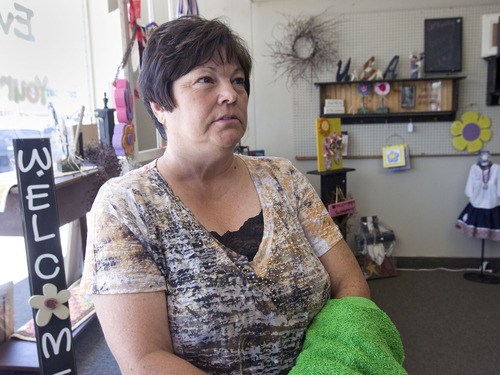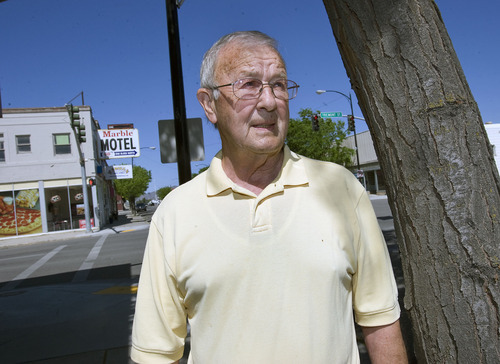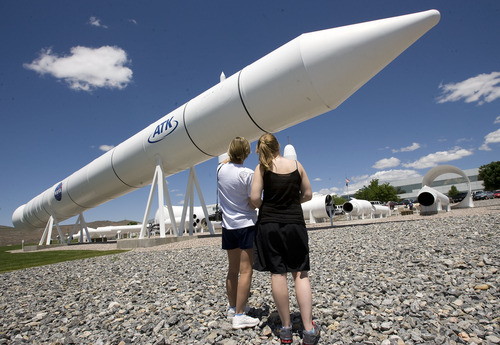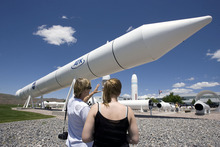This is an archived article that was published on sltrib.com in 2011, and information in the article may be outdated. It is provided only for personal research purposes and may not be reprinted.
Promontory • For more than three decades, NASA's space shuttle program served as a cornerstone of Utah's economy.
Yet that era is about to end. The space shuttle is scheduled to fly for the last time Friday, but the fallout from that final launch already is being felt throughout the state.
Gone are hundreds of millions of dollars the National Aeronautics and Space Administration spent every year in Utah to test, build and buy the solid-fuel rocket booster motors critical to lifting the space shuttle into low Earth orbit. Gone, too, are thousands of jobs that spending helped support.
"I never thought they should end the shuttle program until there was a replacement for it," said Jake Garn, a one-time shuttle astronaut and former U.S. senator. "It has been a big boon to Utah, and I just hate to see the program come to an end."
While closed storefronts, unemployment lines and "For Sale" signs in front yards throughout northern Utah may now be forever linked in many people's minds to the program's end, other images also linger from the shuttle's heyday.
They are of busloads of Utah schoolchildren, eyes wide, watching a static ground firing of a single shuttle booster motor on the hills west of Brigham City. They are of families gathered around the TV, watching the shuttle on the screen climb into the sky over the Atlantic Ocean, and of astronauts such as Garn at work while orbiting the Earth.
"When I watch the space shuttle lifting off, it is overwhelming. I am in awe that human beings can actually come together and do that kind of work," said Fred Perkins, chief shuttle engineer at Alliant Tech Systems, the company whose Utah-based aerospace system group produced the shuttle booster motors.
On clear nights, Perkins often looks up to see the International Space Station fly past. It represents a million tons of equipment that ATK's booster motors helped put into orbit aboard the shuttle. "And you can watch it in the sky as if it were a new star."
The program's end doesn't mean the future will be all doom and gloom in Utah. The legacy of the state's involvement in the shuttle program will continue to be felt long after the two solid-fuel rocket booster motors strapped to space shuttle Atlantis flame out two minutes after the last liftoff.
ATK almost certainly will be involved in the nation's future space-flight efforts, which virtually guarantees Utah will play a role.
But until NASA again sends astronauts into space aboard an American-made rocket, the tough times resulting from the program's end likely will continue. And nowhere will there be more pain than in Box Elder County, the home of ATK's Promontory plant, where booster motors were assembled and tested.
"The economy in Box Elder County is going to be adjusting ... for some time to come," said John Matthews, a labor market economist at the Utah Department of Workforce Services who tracks northern Utah's workforce.
Unemployment in Box Elder County now stands at 9.2 percent, according to the latest available statistics, significantly higher than the state's 7.3 percent average, Matthews said. And a lot of that difference can be traced to those couple of thousand workers let go from ATK since 2009, when the shuttle program started to wind down.
Cindy Sorensen, who lives in Howell, a small farming community north of ATK's Promontory plant, knows firsthand of the problems the end of the shuttle program has brought.
For several years she operated a small boutique in Tremonton — Simply Ours — but shut it down six months ago due to the lingering recession and the side effects of NASA's waning presence in the area. "I hate to see the program end. It has just taken away so many jobs."
Employment at ATK and its predecessor, Thiokol Corp., typically ebbed and flowed over the years with the availability of federal space and defense contracts — so layoffs aren't anything new. But this time, given that they coincided with the steep slowdown in economic growth nationally, there is more pessimism than ever.
"It has been really devastating for a lot of people around here," said Leon Payne, a 71-year-old Tremonton resident and ATK retiree who recently saw of his two brothers-in-law and a son let go from the rocket motor maker.
"When I look at ATK now, it just seems to be pretty simple and straightforward what they need," Payne said. "They need new contracts so they can do some new development work and start making more things."
Payne joined Thiokol Corp. in 1958, right out of high school. He worked with thousands of others on the first space shuttle launch in 1981. They felt they were working on something special. He later moved to the defense side of the company and worked on the propellant program.
"It was a good place to work, and it helped build me a home, buy a little property and raise three kids. And I wasn't the only one. Those jobs helped put a lot of meals on a lot of tables," he said. "But I'm worried it could be a long time before we see those jobs return."
Former Tremonton Mayor Max Weese, who worked at Thiokol in the 1960s and 1970s, said even residents who didn't work at ATK's Promontory plant were often reminded of its importance by the periodic test firings in the hills to the west.
"You could hear it and see the exhaust climbing into the sky," he said. "It would rattle windows, and sometimes there would be dust settling on the cars. But if they made a mess in your yard, you could always call them and they'd come out and clean it up."
Weese is confident jobs will come back and the test firings will roar once again with the exhaust plumes climbing thousands of feet into the sky. He's not sure when, but he hopes it will be soon.
"We worked hard over the years trying to diversify our economy and bring in other industries," he said, pointing to successes such as Malt-O-Meal, Auto-Liv, West Liberty Foods and Proctor & Gamble's new plant nearby. "But it would be great if we had something [new hiring] going on at ATK, too."
Late last week, Ronda Reynolds of Idaho Falls, Idaho, and her granddaughter Devan stopped in at ATK's "Rocket Garden" outside the Promontory plant and gazed at a mock-up of a space shuttle booster.
Although she has never seen a space shuttle launch or watched an ATK ground test, Reynolds nevertheless said she felt an affinity with the program. Her late husband Walter was the COB, or "chief of the boat" — the top enlisted man — on the submarine that picked up the spent booster motor with the damaged O-ring from the Challenger disaster.
"I really have mixed feelings about the shuttle program coming to an end. I know there still is a lot that we can learn but at the same time there are a lot of things we need to do down here [on Earth]," she said.
Retired Utah Congressman James V. Hansen, who represented Box Elder County in the U.S. House from 1981 to 2003, said despite the ups and downs, the state has prospered because of the space shuttle program.
"I can't think of anything in my lifetime that has created more new things and advanced the sciences more than the space program," he said. "Even with the tragedies — Challenger and Columbia — it still was well worth it."
Twitter: OberbeckBiz









